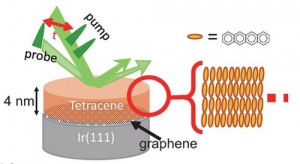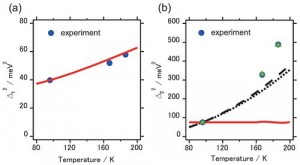This website uses cookies to ensure a better user experience.
To get more information, please read our Cookie Statement.
Anomalous temperature dependence of exciton spectral diffusion in tetracene thin film
Our colleagues Marin Petrović and Marko Kralj, in collaboration with researchers from Kyoto University, published a study in high-ranking Journal of Physical Chemistry Letters. Utilization of epitaxial graphene as a substrate for preparation of high-quality tetracene thin film enabled characterization of new processes relevant to exciton spectral diffusion in tetracene.
Anomalous temperature dependence of exciton spectral diffusion in tetracene thin film
Tatsuya Yoshida, Kazuya Watanabe, Marin Petrović, and Marko Kralj, The Journal of Physical Chemistry Letters 11, 5248 (2020).
DOI: https://dx.doi.org/10.1021/acs.jpclett.0c01537
Excitons are bound-states of electron-hole pairs which can be found in different quantum systems, including molecules. Exciton dynamics of molecular systems depends on several parameters: magnitude of exciton energy fluctuation and the corresponding correlation time, exciton-phonon coupling, and intermolecular excitonic coupling. The actual exciton dynamics of molecular aggregates is governed by a fine interplay among these parameters, and is therefore often obscured from experimental measurements.
The authors utilize two-dimensional electronic spectroscopy (2DES) to investigate spectral diffusion of excitons in 4 nm thin film of tetracene. The film has been deposited on a single layer of graphene on Ir(111) (see Figure 1). Atomic flatness of graphene and its perfect alignment to the underlying Ir single-crystal enabled preparation of a structurally well-defined tetracene film. Such tetracene samples are free of inherent inhomogeneity, which is an advantage compared to previous studies, and are excellent candidates for investigation of different processes governing exciton dynamics.

Figure 1. Schematic illustration of the tetracene thin film fabricated on a graphene-covered Ir(111) substrate. 2DES measurement has been carried out in UHV with a reflection geometry as illustrated. Tetracene molecules are stacked in a layer-by-layer fashion with a herringbone structure.
From 2DES measurements and complementary theoretical modeling, the authors find that the spectral diffusion of the lowest-laying exciton in tetracene is dominated by two processes, whose magnitudes show different temperature dependence (see Figure 2). The first process corresponds to linear coupling to phonons, and the second one stems from anharmonic coupling between low-frequency phonons and high-frequency intramolecular phonons. These findings provide a new insight into ultrafast nonadiabatic dynamics of molecular excitons, and can serve as a valuable input for future theoretical predictions of similar processes.

Figure 2. Temperature dependence of exciton energy fluctuation of the two components (∆1– linear coupling to phonons, and ∆2– anharmonic coupling between low-frequency phonons and high-frequency intramolecular phonons) extracted from 2DES measurements. Red and black lines are fits to different theoretical models.




